There’s no question that the average cost of a college education in the U.S. is increasing. And if you relied on student loans to help pay your way, the monthly payment obligation post-graduation can seem daunting.
Still, even though the decision to pursue higher education can be a costly one, experts continue to point to the long-term benefits of getting a degree. In addition to having access to higher-paying jobs, a chance for better financial security after school, and several years’ worth of networking opportunities, there are other less obvious benefits to being a college graduate. Studies show people who go to college are more likely to be satisfied with the work they do and happy with their situation.
For first-generation students, though, the decision to go to college or where to study can be even more complicated. For a closer look at the choices they have to make, we surveyed over 1,000 former first- and continuing-generation college students to understand their motivations for enrolling, how their experiences differed, and how they paid for their education. Read on to see what we discovered.
Education Inspiration
According to the National Center for Education Statistics (NCES), 1 in 3 college students are first generation. These students are defined as those enrolled in postsecondary education whose parents had no postsecondary education experience.
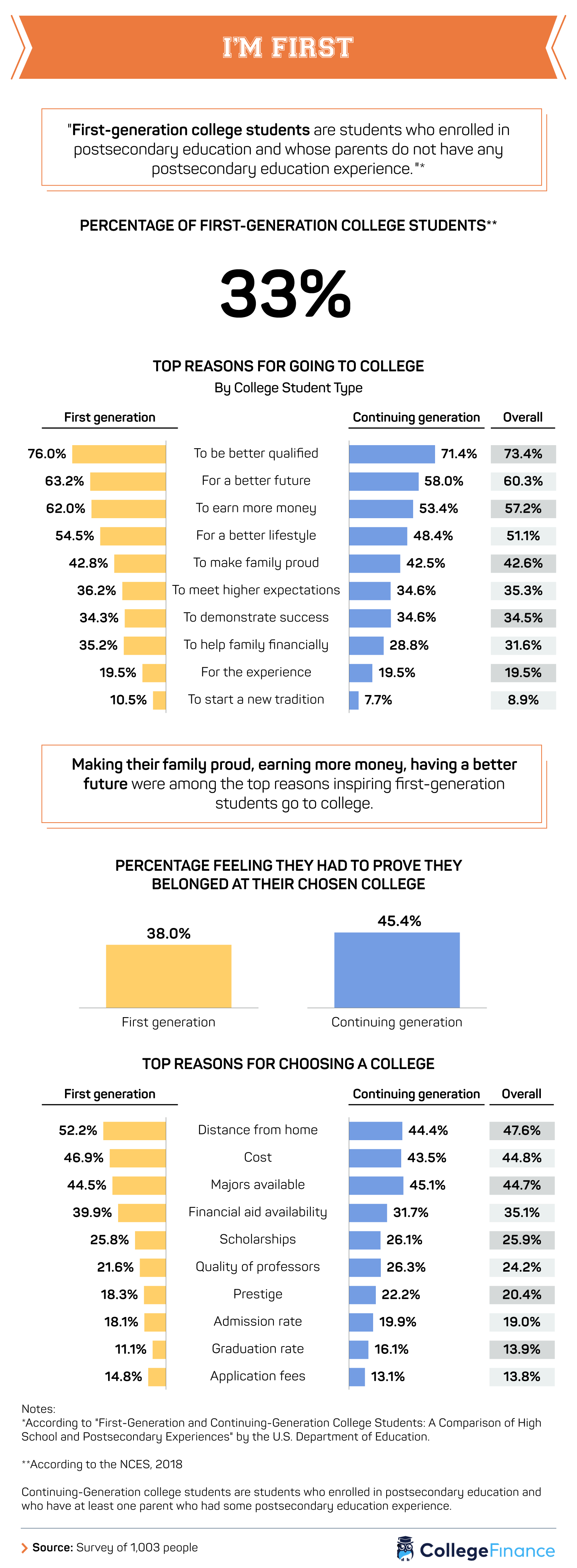
Despite having different motivations, students of all backgrounds were most likely to say they decided to attend college to be better qualified (73.4%), including 76% of first-generation and around 71% of continuing-generation students. However, first-generation college students seemed to be more motivated by the opportunity to go to school. First-generation students were nearly 9 percentage points more likely than continuing-generation students to desire to make more money and 6 percentage points more likely to identify a better lifestyle as inspiration for continuing their education.
First-generation students were also less likely to feel they had to prove they belonged at their schools (38%) compared to those whose parents had also attended college (45%). First-generation college students more commonly listed distance from home and cost as reasons they selected their current institutions, compared to the available majors and the quality of professors for continuing-generation respondents.
College Difficulties
For students without a family history involving postsecondary education, the college experience can be a very different landscape. More than 4 in 5 first-generation college students experienced academic challenges, and over half experienced social challenges during their time in school. While 29% of first-generation college students considered dropping out of college at some point, close to 13% of all students surveyed did drop out.
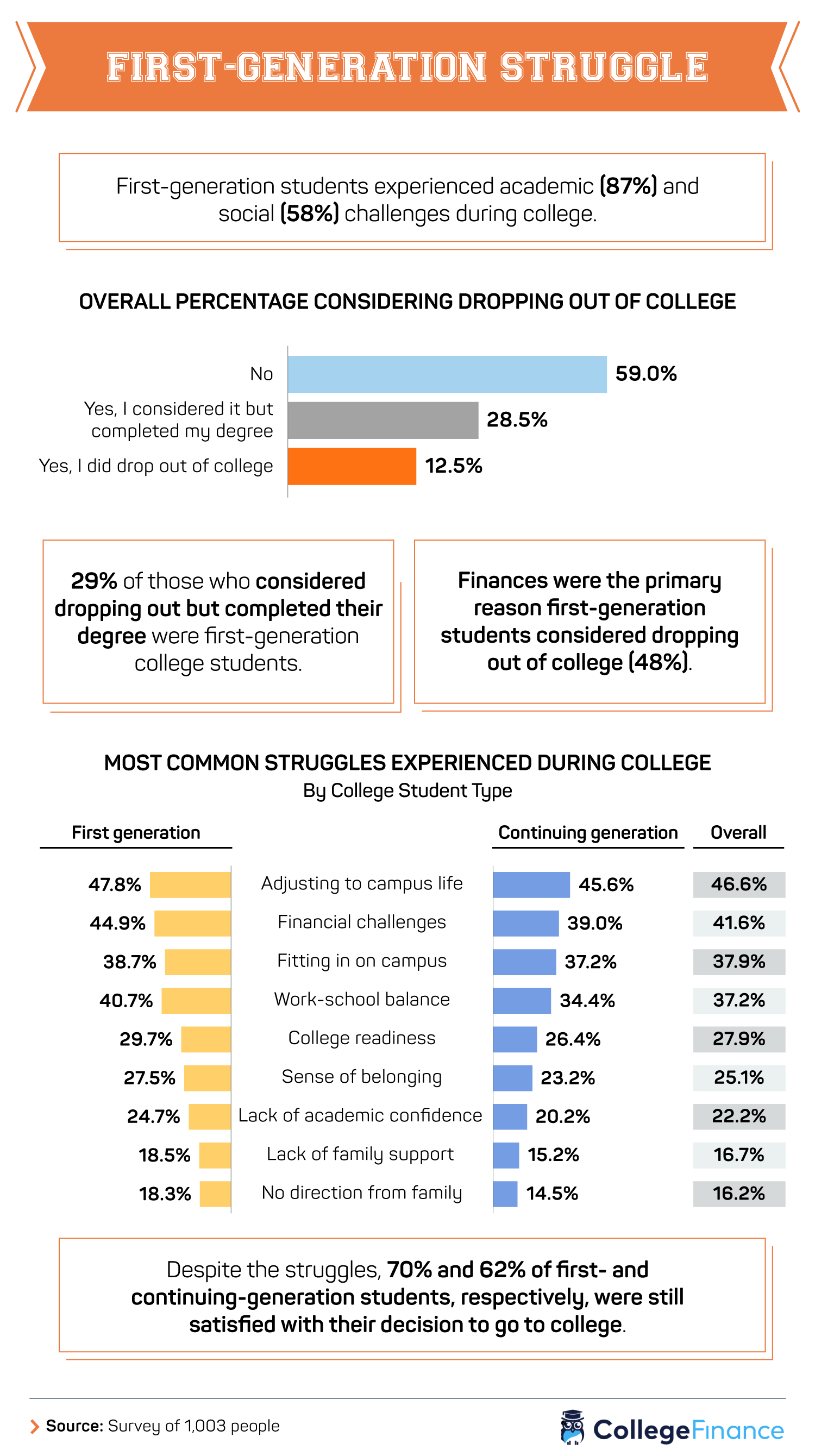
Finances were the primary reason first-generation college students contemplated dropping out. Additionally, first-generation students were more likely than continuing-generation students to have difficulty adjusting in every category surveyed, ranging from family support to work-school balance.
Despite these challenges, 70% of first-generation college students were extremely or very satisfied with their decision to go to college.
Money Matters
Being a first-generation college student doesn’t just mean you won’t be able to lean on your parents for their experiences or advice. It could mean that you know less about the higher education system (including when or how to apply for aid) and are more likely to experience guilt for moving away from home. For these first-in-family students, the financial obligation, even with scholarships and grants, can be both unexpected and overwhelming.
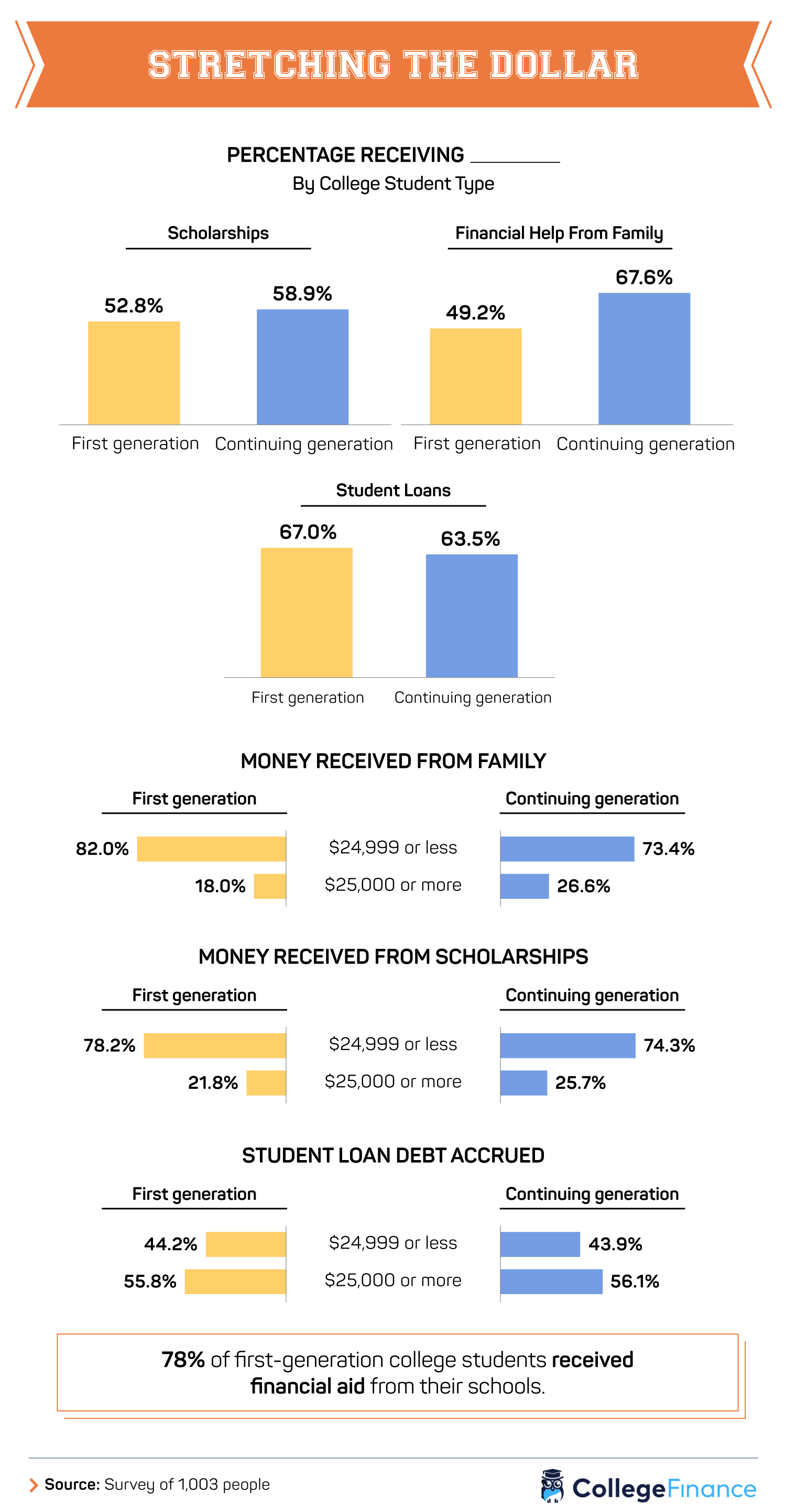
Continuing-generation students were more likely to receive both scholarships (59%) and financial help from their families for school (nearly 68%). While roughly half of first-generation students received money from their relatives to help finance their education, for more than 4 in 5 students, the money provided was less than $25,000. Compared to 18% of first-generation students, almost 27% of continuing-generation students received $25,000 or more in aid from their families. Among students receiving money in the form of scholarships, financial support was also more likely to be lower among first-generation students than those with a family history of postsecondary education.
Separation of Class and Home
In the same way that a work-life balance is crucial, students must also find a balance between their academic obligations and life outside the classroom. In recent years, schools have seen an increase in the number of students experiencing anxiety and depression and relying on on-campus counselors for support.
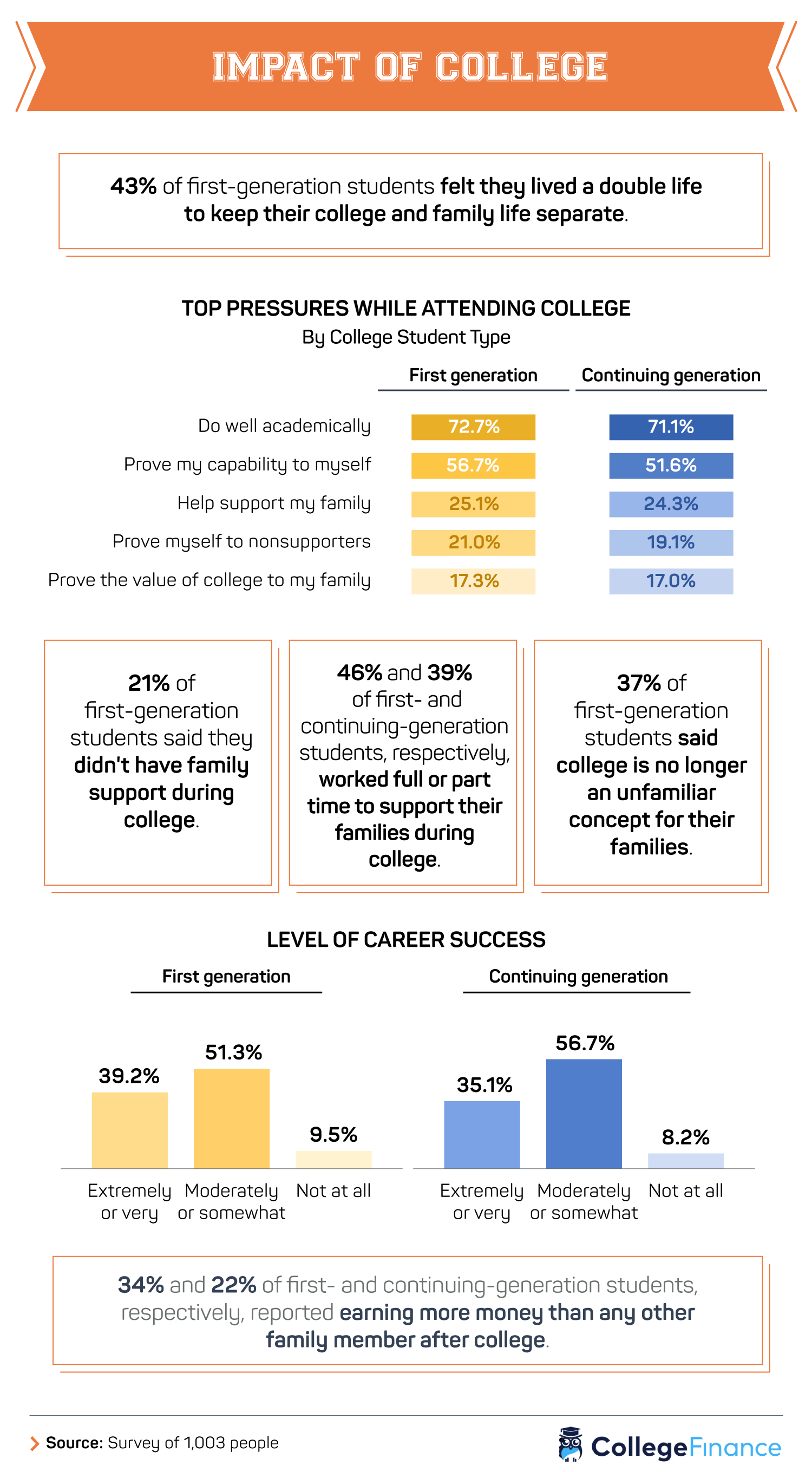
More than 2 in 5 first-generation students felt they lived a double life keeping their academic and personal life separate. The top pressures for students included the ability to do well academically, being able to prove their capabilities to themselves, and supporting their families. However, first-generation respondents had a higher likelihood of feeling driven by each scenario.
For many, these pressures are compounded by the lack of understanding or support they receive at home. Roughly 1 in 5 first-generation students indicated not having support from their families during college, and closer to half also reported working part- or full-time jobs during their school years. First-generation college students were also more likely to feel extremely or very successful in their careers (39%) compared to continuing-generation students (35%).
Insider Inspiration
So, what does it take to turn the college experience into a success if you’re the first person in your family to attend? More than anything else, students pointed to their organization habits (57%), class attendance (nearly 53%), and being proactive about financial assistance (almost 47%) as the most significant contributions to their college tenure. Other popular responses included being able to ask for help as often as necessary, being confident, and using available resources.
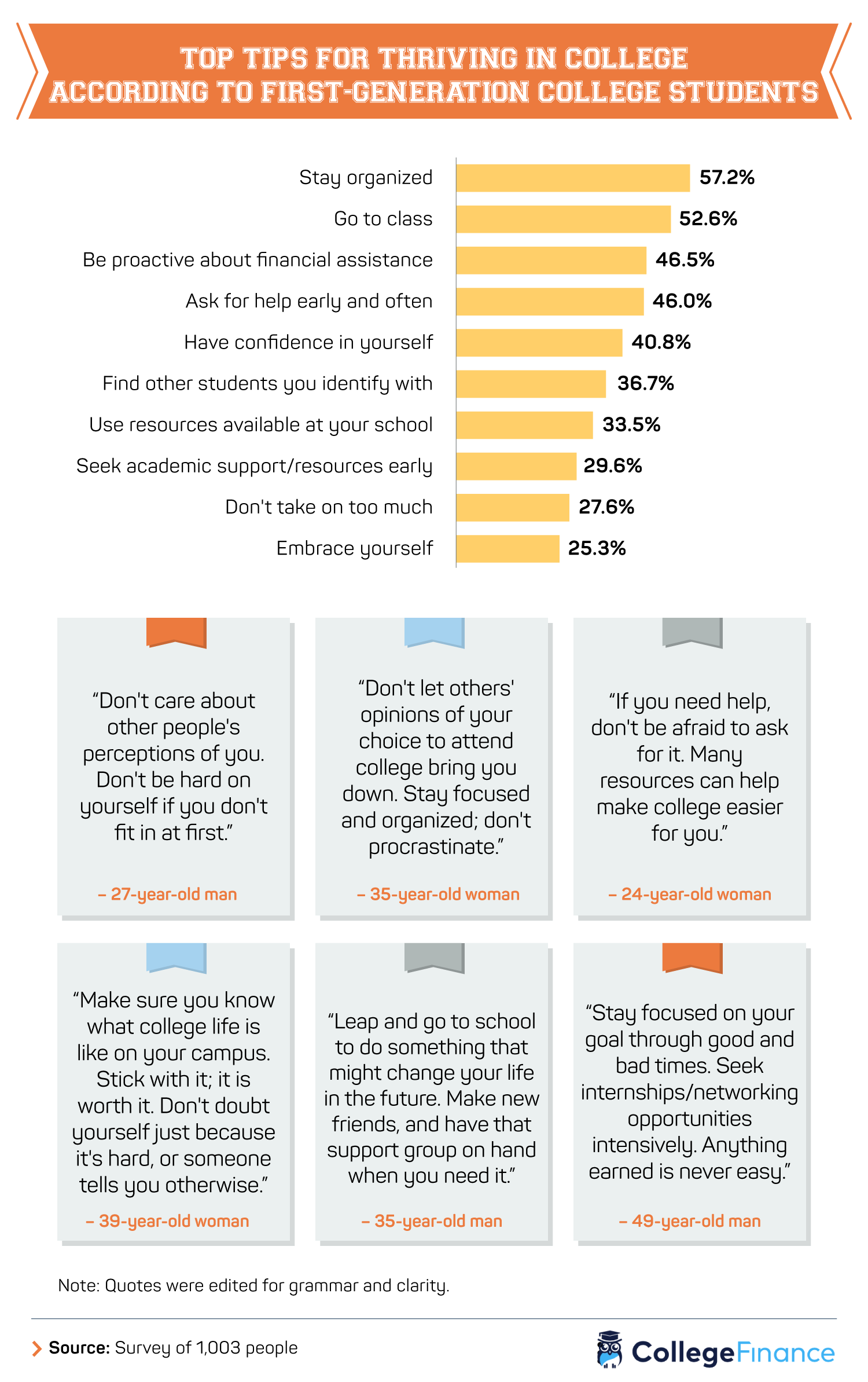
As one 27-year-old man indicated, “Don’t care about other people’s perceptions of you,” and another 35-year-old man encouraged others to “go to school to do something that might change your life in the future.” Despite the challenges, these students had positive, helpful advice on how to survive college when you can’t ask your parents about their experiences.
Making the Most of College
Even when students share classes or participate in the same extracurricular activities, their college experience can be very different based on family history with higher education.
Among the first-generation college students surveyed, the motivation to attend school and the pressures they faced once they got there were more significant. Perhaps as a result of not having past experiences to lean on, first-generation college students were less likely to receive scholarships or financial aid from their families and were more likely to feel financial pressure or work a part- or full-time job during their school years. However, while the challenges may have been steeper, first-generation college students were also more likely to feel satisfied with their careers after college and to appreciate the decision to go in the first place.
At CollegeFinance, we want to help you get the most out of your college experience. Whether you are planning, ready to borrow, or starting to pay back your student loans, our financial aid guides will be with you every step of the way. With the resources you need for your college journey, we’re committed to helping you make the best decisions about financing your educational future. Learn more at CollegeFinance.com today.
Methodology
We surveyed 1,003 former first-generation (439) and continuing-generation (564) college students. To qualify, respondents had to have been enrolled in at least some college and had to be employed.
Respondents had to answer questions about their college experiences, which included questions about financial aid, scholarships, student loans, family financial help, family support, and struggles.
Respondents ranged in age from 24 to 57 with an average age of 35 and a standard deviation of 8. Fifty-one percent of respondents identified as women, and 49% identified as men. For short, open-ended questions, outliers were removed. To ensure that all respondents took our survey seriously, they were required to identify and correctly answer an attention-check question.
We used the following sources:
Limitations
These data rely on self-reporting by the respondents and are only exploratory. Issues with self-reported responses include, but aren’t limited to, exaggeration, selective memory, telescoping, attribution, and bias. All values are based on estimation.
Fair Use Statement
To share this story with your readers for any noncommercial use, we simply ask that you include a link back to this page as a credit to our incredible team of contributors who assembled and illustrated these findings.

